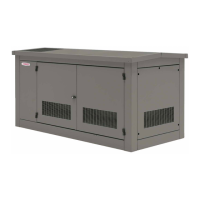XP-6341 6/108 Section 1 General
Section 1 General
1.1 Introduction
Review this section and the Safety Precautions before
starting the installation procedure. The generator set
specification sheet also contains data that may be
required during the installation process.
The generator set and accessories must be installed by
a Lennox dealer or authorized representative. The
installation must comply with all applicable national and
local codes.
1.2 Enclosed Generator Sets
Install the generator set outdoors. Enclosed generator
sets include a factory-supplied sound enclosure. The
exhaust systems of enclosed units are complete for
outdoor installations. Review Section 1 and then refer to
Section 2 for the outdoor installation of enclosed units.
Note: DO NOT install enclosed units inside a
building.
1.3 Unit-Mounted Radiator
Cooling
The generator set is equipped with a unit-mounted
radiator common c ooling system.
1.3.1 Cooling System Features
The system’s major components include an engine-
driven fan and circulating water pump, a radiator, and a
thermostat. The pump circulates water through the
engine until it reaches operating temperature. Then the
engine thermostat opens, allowing water circulation
through the radiator. The thermostat restricts water flow
as necessary to prevent overcooling. The fan blows air
from the engine side of the radiator across the cooling
surface.
1.3.2 Recommended Coolant
Add coolant before starting the generator set or
energizing the block heater.
The generator set manufacturer recommends a solution
of 50% ethylene glycol and 50% clean, softened water to
provide freezing protection to --37_C(--34_F) and
boiling protection to 129_C (256_F). A 50/50 solution
also inhibits corrosion. Consult the engine manufacturer’s
instructions for engine coolant specifications. See the
List of Related Materials in the Introduction.
1.4 Block Heater
Use block heaters on all standby applications where the
generator set is subject to temperatures below 16°C
(60°F). Connect the block heater to a power source that
is energized when the generator set is not running.
Note: Block heater damage. The block heater will fail
if the energized heater element is not immersed
in coolant. Fill the cooling system before turning
on the block heater. Run the engine until it is
warm and refill the radiator to purge the air from
the system before energizing the block heater.
1.5 Fuel Supply
Gas fuel systems operate on either LP (liquefied
petroleum) or natural gas. Refer to the the instructions
in Section 2.2.5 for more detailed information on fuel
requirements.
Note: Design and install gas fuel systems in
accordance with NFPA-54, National Fuel Gas
Code, and applicable local codes.
1.5.1 Fuel Lines
Gas lines. Never use fuel piping to ground electrical
equipment. The gas supplier is responsible for
installation, repair, and alteration to gas piping.
Use Schedule 40 black-iron pipe for gas piping. Copper
tubing may be used if the fuel does not contain hydrogen
sulfide or other ingredients that react chemically with
copper.
Line size. Size piping according to the requirements of
the equipment. Refer to the the instructions in
Section 2.2.5. In addition to actual fuel consumption,
consider the following pressure loss factors:
D Pipe length
D Other appliances on the s ame fuel supply
D Number of fittings
Flexible connections. Rigid mount the piping but
protect it from vibration. Use flexible connections
spanning a minimum of 152 mm (6 in.) between the
stationary piping and the engine fuel inlet connection.
1.5.2 Gas Regulators
Gas regulators reduce high incoming fuel pressures to
lower levels acceptable for engines. See the generator

